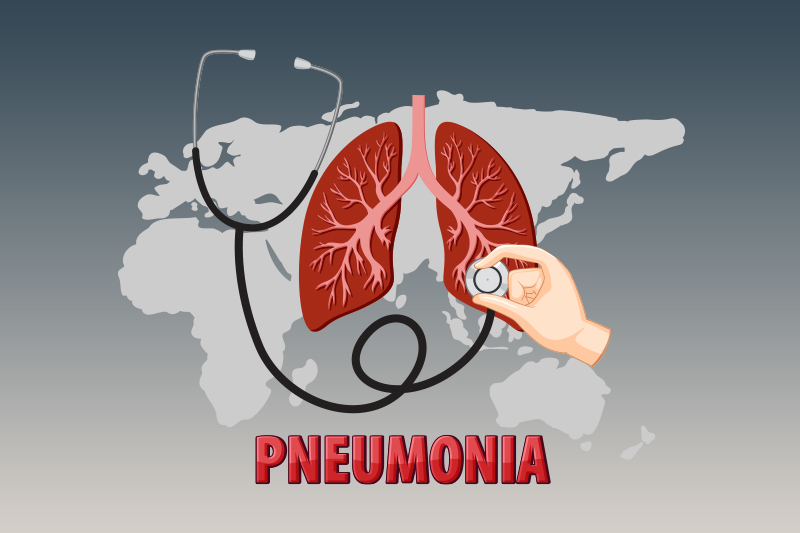Pneumonia is a common lung infection caused by bacteria, viruses, or fungi. It leads to inflammation in the lungs, which fill with fluid or pus, with symptoms such as cough with phlegm, fever, chills, and difficulty breathing. The severity of pneumonia can vary from mild to life-threatening. Influenza, COVID-19 and pneumococcal disease are common causes of this lung infection. According to CDC data, more than 41,000 people in the United States died from pneumonia in 2022.
Pneumonia can be classified as either simple or complex, and accurate diagnosis is essential for effective treatment and proper reimbursement. A range of diagnostic tests and procedures are used to evaluate lung function, confirm the diagnosis, and determine the underlying cause of the infection. Identifying the type of pneumonia – such as bacterial, viral, aspiration, or hospital-acquired – is crucial for clinical management and precise medical coding. Outsourcing medical coding to certified professionals can support physicians by improving coding accuracy and optimizing revenue cycle management (RCM).
Partner with certified experts for accurate billing and faster reimbursements.
Focus on patient care while we handle the coding!
Diagnosing Pneumonia
Pneumonia is sometimes hard to diagnose because the symptoms are similar to a cold or flu. A chest X-ray is commonly used to detect lung inflammation, while blood tests like a complete blood count (CBC) check for signs of infection. Pulse oximetry measures blood oxygen levels, as pneumonia can affect oxygen intake.
For more severe cases or hospitalized patients, additional tests may be necessary. An arterial blood gas test assesses oxygen levels directly from the blood, and a sputum test helps identify the germ responsible for pneumonia. A blood culture checks whether a bacterial infection has spread to the bloodstream, while a PCR test rapidly detects bacterial or viral DNA.
Advanced imaging, such as a chest CT scan, provides a detailed view of lung involvement and potential complications. In some cases, a bronchoscopy may be performed to examine the airways and collect lung samples. If fluid accumulates around the lungs, a pleural fluid culture using thoracentesis can help determine the cause of the infection.
Pneumonia is usually suspected based on symptoms and chest X-ray findings. However, it’s often hard to tell if the cause is bacterial or viral because there are no clear tests to confirm this. As a result, providers often classify cases as Community-acquired pneumonia (CAP) or Hospital/healthcare-associated pneumonia (HAP/HCAP).
When specific diagnosis codes are supported by the medical record and clinical knowledge, they should be used. But if the cause isn’t clear, using symptom-based or unspecified codes may be more accurate. Each encounter should be coded based on the level of certainty available at that time.
Pneumonia ICD-10 Codes
ICD-10 codes for pneumonia are categorized based on the underlying cause, such as bacterial, viral, fungal, or aspiration pneumonia, as well as the type and setting of the infection – whether community-acquired, hospital-acquired, or ventilator-associated. The most commonly used codes are:
J18.1 Lobar pneumonia, unspecified organism
J18.0 Bronchopneumonia, unspecified organism
J18.1 Lobar pneumonia, unspecified organism
J18.2 Hypostatic pneumonia, unspecified organism
J18.8 Other pneumonia, unspecified organism
J18.9 Pneumonia, unspecified organism (billable)
J12.0 Adenoviral pneumonia (billable)
J12.1 Respiratory syncytial virus pneumonia (billable)
J12.2 Parainfluenza virus pneumonia (billable)
J12.3 Human metapneumovirus pneumonia (billable)
J12.8 Other viral pneumonia
J12.81 Pneumonia due to SARS-associated coronavirus (billable)
J12.82 Pneumonia due to coronavirus disease 2019 (billable)
J12.89 Other viral pneumonia (billable)
While both codes J12.8 and J12.89 represent Other viral pneumonia, J12.89 is billable as it is more specific and includes conditions like pneumonia due to SARS-associated coronavirus or COVID-19.
Other ICD-10 codes for pneumonia:
J13 Pneumonia due to Streptococcus pneumoniae
Bronchopneumonia due to S. pneumoniae
Code also, if applicable, any associated condition such as: abscess (J85.1)
aspiration pneumonia (J69.-)
Code first if applicable, associated influenza (J09.X1, J10.0-, J11.0-)
J14 Pneumonia due to Hemophilus influenza
Bronchopneumonia due to H. influenzae
Code also, if applicable, any associated condition such as:
abscess (J85.1), aspiration pneumonia (J69.-)
Code first if applicable, associated influenza (J09.X1, J10.0-, J11.0-)
J15 Bacterial pneumonia, not elsewhere classified
J15.0 Pneumonia due to Klebsiellapneumoniae
J15.1 Pneumonia due to Pseudomonas
J15.2 Pneumonia due to staphylococcus
J15.20 …… unspecified
J15.21 Pneumonia due to staphylococcus aureus
J15.211 Pneumonia due to Methicillin susceptible Staphylococcus aureus
J15.212 Pneumonia due to Methicillin resistant Staphylococcus aureus
J15.29 Pneumonia due to other staphylococcus
J15.3 Pneumonia due to streptococcus, group B
J15.4 Pneumonia due to other streptococci
J15.5 Pneumonia due to Escherichia coli
J15.6 Pneumonia due to other Gram-negative bacteria
J15.7 Pneumonia due to Mycoplasma pneumoniae
J15.8 Pneumonia due to other specified bacteria
J15.9 Unspecified bacterial pneumonia
J16 Pneumonia due to other infectious organisms, not elsewhere classified
J16.0 Chlamydial pneumonia
J16.8 Pneumonia due to other specified infectious organisms
Code also, if applicable, any associated condition such as: abscess (J85.1) aspiration pneumonia (J69.-). Code first, if applicable, associated influenza (J09.X1, J10.0-, J11.0-)
J17 Pneumonia in diseases classified elsewhere
Code also, if applicable, any associated condition such as: abscess (J85.1), aspiration pneumonia (J69.-). Code first underlying disease, such as: Q fever (A78), rheumatic fever (I00), schistosomiasis (B65.0-B65.9).
HAP vs. CAP Pneumonia Documentation
HAP occurs 48 hours or more after hospital admission and is not incubating at the time of admission. It often involves multi-resistant organisms like Pseudomonas aeruginosa or MRSA. Documentation should highlight the hospital setting, risk factors (e.g., surgery, acute stroke), and any systemic inflammatory response.
CAP develops outside the hospital or within the first 48 hours of admission. It is commonly caused by pathogens like Streptococcus pneumoniae, Haemophilus influenzae, or Moraxella catarrhalis. Documentation should specify the type of pneumonia, clinical indicators (e.g., fever, cough), and diagnostic findings like chest X-rays.
Accurate documentation of HAP and CAP is crucial for coding, reimbursement, and risk adjustment. An article from the Association of Clinical Documentation Integrity Specialists (ACDIS) notes: “Regardless of whether the pneumonia was CAP or HAP, CDI professionals should query the physician to determine the pathogen causing the condition. Sometimes, a physician will write one or the other to differentiate between a simple versus complex case. Without knowing the underlying organism, a CDI specialist cannot determine the DRG”.
Ensure Accurate Claim Submission through Expert Coding Services
Accurate coding and billing for pneumonia can be complex due to the variety of causes, severity levels, and associated complications. Selecting the correct ICD-10 code requires a thorough understanding of clinical documentation, coding guidelines, and payer-specific requirements. Additionally, pneumonia cases often involve multiple tests, treatments, and comorbid conditions, which can lead to claim denials or reimbursement delays if not reported correctly on claims.
Outsourcing RCM to experienced professionals can help healthcare providers reduce errors, improve compliance, and streamline revenue cycle management. Expert coders evaluate the documentation carefully to identify and code pneumonia correctly. They stay updated with ICD-10 changes, payer policies, and industry regulations, ensuring accurate claim submissions and minimizing denials. With efficient medical billing and coding outsourcing solutions, providers can focus on patient care while reducing administrative burdens and optimizing financial performance.
Reduce denials and boost revenue!
Contact us today to streamline your billing and coding!




